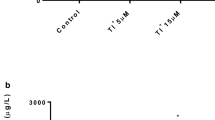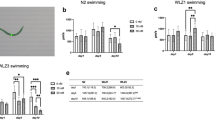Abstract
Mercury (Hg) is a persistent environmental bioaccumulative metal, with developmental exposure to methylmercury (MeHg) resulting in long-term health effects. We examined the impact of early-life exposure to MeHg and knockdown of skn-1 on dopaminergic (DAergic) neurodegeneration in the nematode Caenorhabditis elegans. SKN-1, a the major stress-activated cytoprotective transcription factors, promotes the transcription of enzymes that scavenge free radicals, synthesizes glutathione and catalyzes reactions that increase xenobiotic excretion. Deletions or mutations in this gene suppress stress resistance. Thus, we hypothesized that the extent of MeHg’s toxicity is dependent on intact skn-1 response; therefore skn-1 knockout (KO) worms would show heightened sensitivity to MeHg-induced toxicity compared to wildtype worms. In this study we identified the impact of early-life MeHg exposure on Hg content, stress reactivity and DAergic neurodegeneration in wildtype, and skn-1KO C. elegans. Hg content, measured by Inductively Coupled Plasma Mass Spectrometry, showed no strain-dependent differences. Reactive oxygen species generation was dramatically increased in skn-1KO compared to wildtype worms. Structural integrity of DAergic neurons was microscopically assessed by visualization of fluorescently-labeled neurons, and revealed loss of neurons in skn-1KO and MeHg exposed worms compared to wildtype controls. Dopamine levels detected by High-performance liquid chromatography, were decreased in response to MeHg exposure and decreased in skn-1KO worms, and functional behavioral assays showed similar findings. Combined, these studies suggest that knockdown of skn-1 in the nematode increases DAergic sensitivity to MeHg exposure following a period of latency.








Similar content being viewed by others
References
Ni M et al (2010) Methylmercury induces acute oxidative stress, altering Nrf2 protein level in primary microglial cells. Toxicol Sci 116(2):590–603
An JH, Blackwell TK (2003) SKN-1 links C. elegans mesendodermal specification to a conserved oxidative stress response. Genes Dev 17(15):1882–1893
Vanduyn N et al (2010) SKN-1/Nrf2 inhibits dopamine neuron degeneration in a Caenorhabditis elegans model of methylmercury toxicity. Toxicol Sci 118(2):613–624
Kaidery NA et al (2013) Targeting Nrf2-mediated gene transcription by extremely potent synthetic triterpenoids attenuate dopaminergic neurotoxicity in the MPTP mouse model of Parkinson’s disease. Antioxid Redox Signal 18(2):139–157
Ramsey CP et al (2007) Expression of Nrf2 in neurodegenerative diseases. J Neuropathol Exp Neurol 66(1):75–85
Lastres-Becker I et al (2012) Alpha-Synuclein expression and Nrf2 deficiency cooperate to aggravate protein aggregation, neuronal death and inflammation in early-stage Parkinson’s disease. Hum Mol Genet 21(14):3173–3192
Gorell JM et al (1999) Occupational exposure to manganese, copper, lead, iron, mercury and zinc and the risk of Parkinson’s disease. Neurotoxicology 20(2–3):239–247
Gutteridge JM (1995) Lipid peroxidation and antioxidants as biomarkers of tissue damage. Clin Chem 41(12 Pt 2):1819–1828
Recchia A et al (2004) Alpha-synuclein and Parkinson’s disease. FASEB J 18(6):617–626
Aschner M et al (2007) Involvement of glutamate and reactive oxygen species in methylmercury neurotoxicity. Braz J Med Biol Res 40(3):285–291
Zhang P et al (2009) In vitro protective effects of pyrroloquinoline quinone on methylmercury-induced neurotoxicity. Environ Toxicol Pharmacol 27(1):103–110
Chiueh CC et al (1994) In vivo generation of hydroxyl radicals and MPTP-induced dopaminergic toxicity in the basal ganglia. Ann N Y Acad Sci 738:25–36
Dabbeni-Sala F et al (2001) Melatonin protects against 6-OHDA-induced neurotoxicity in rats: a role for mitochondrial complex I activity. FASEB J 15(1):164–170
De Iuliis A et al (2005) A proteomic approach in the study of an animal model of Parkinson’s disease. Clin Chim Acta 357(2):202–209
Sherer TB et al (2003) Subcutaneous rotenone exposure causes highly selective dopaminergic degeneration and alpha-synuclein aggregation. Exp Neurol 179(1):9–16
Riederer P et al (1989) Transition metals, ferritin, glutathione, and ascorbic acid in parkinsonian brains. J Neurochem 52(2):515–520
Sian J et al (1994) Alterations in glutathione levels in Parkinson’s disease and other neurodegenerative disorders affecting basal ganglia. Ann Neurol 36(3):348–355
Sian J et al (1994) Glutathione-related enzymes in brain in Parkinson’s disease. Ann Neurol 36(3):356–361
Sofic E et al (1992) Reduced and oxidized glutathione in the substantia nigra of patients with Parkinson’s disease. Neurosci Lett 142(2):128–130
Bender A et al (2006) High levels of mitochondrial DNA deletions in substantia nigra neurons in aging and Parkinson disease. Nat Genet 38(5):515–517
Cantuti-Castelvetri I et al (2005) Somatic mitochondrial DNA mutations in single neurons and glia. Neurobiol Aging 26(10):1343–1355
Kraytsberg Y et al (2006) Mitochondrial DNA deletions are abundant and cause functional impairment in aged human substantia nigra neurons. Nat Genet 38(5):518–520
Swerdlow RH et al (1996) Origin and functional consequences of the complex I defect in Parkinson’s disease. Ann Neurol 40(4):663–671
Gorell JM et al (1999) Occupational metal exposures and the risk of Parkinson’s disease. Neuroepidemiology 18(6):303–308
Gao Y et al (2008) Effects of methylmercury on postnatal neurobehavioral development in mice. Neurotoxicol Teratol 30(6):462–467
Lin FM, Malaiyandi M, Sierra CR (1975) Toxicity of methylmercury: effects on different ages of rats. Bull Environ Contam Toxicol 14(2):140–148
Maia CS (2010) Inhibitory avoidance acquisition in adult rats exposed to a combination of ethanol and methylmercury during central nervous system development. Behav Brain Res 211(2):191–197
Uchino M et al (1995) Neurologic features of chronic Minamata disease (organic mercury poisoning) certified at autopsy. Intern Med 34(8):744–747
Weiss B, Clarkson TW, Simon W (2002) Silent latency periods in methylmercury poisoning and in neurodegenerative disease. Environ Health Perspect 110(Suppl 5):851–854
Yoshida M et al (2008) Emergence of delayed methylmercury toxicity after perinatal exposure in metallothionein-null and wild-type C57BL mice. Environ Health Perspect 116(6):746–751
Yoshida M et al (2011) Neurobehavioral effects of combined prenatal exposure to low-level mercury vapor and methylmercury. J Toxicol Sci 36(1):73–80
Landrigan PJ et al (2005) Early environmental origins of neurodegenerative disease in later life. Environ Health Perspect 113(9):1230–1233
Helmcke KJ et al (2009) Characterization of the effects of methylmercury on Caenorhabditis elegans. Toxicol Appl Pharmacol 240(2):265–272
Livak KJ, Schmittgen TD (2001) Analysis of relative gene expression data using real-time quantitative PCR and the 2(-delta delta C(T)) method. Methods 25(4):402–408
Sawin ER, Ranganathan R, Horvitz HR (2000) C. elegans locomotory rate is modulated by the environment through a dopaminergic pathway and by experience through a serotonergic pathway. Neuron 26(3):619–631
Burbacher TM, Rodier PM, Weiss B (1990) Methylmercury developmental neurotoxicity: a comparison of effects in humans and animals. Neurotoxicol Teratol 12(3):191–202
Newland MC, Rasmussen EB (2000) Aging unmasks adverse effects of gestational exposure to methylmercury in rats. Neurotoxicol Teratol 22(6):819–828
Dare E et al (2003) Effects of prenatal exposure to methylmercury on dopamine-mediated locomotor activity and dopamine D2 receptor binding. Naunyn Schmiedebergs Arch Pharmacol 367(5):500–508
Reed MN, Newland MC (2009) Gestational methylmercury exposure selectively increases the sensitivity of operant behavior to cocaine. Behav Neurosci 123(2):408–417
Clarkson TW, Magos L (2006) The toxicology of mercury and its chemical compounds. Crit Rev Toxicol 36(8):609–662
Clarkson TW, Magos L, Myers GJ (2003) The toxicology of mercury—current exposures and clinical manifestations. N Engl J Med 349(18):1731–1737
Castoldi AF et al (2008) Neurodevelopmental toxicity of methylmercury: laboratory animal data and their contribution to human risk assessment. Regul Toxicol Pharmacol 51(2):215–229
Goulet S, Dore FY, Mirault ME (2003) Neurobehavioral changes in mice chronically exposed to methylmercury during fetal and early postnatal development. Neurotoxicol Teratol 25(3):335–347
Rodier PM (1995) Developing brain as a target of toxicity. Environ Health Perspect 103(Suppl 6):73–76
Rojo AI et al (2010) Nrf2 regulates microglial dynamics and neuroinflammation in experimental Parkinson’s disease. Glia 58(5):588–598
Rushmore TH, Morton MR, Pickett CB (1991) The antioxidant responsive element. Activation by oxidative stress and identification of the DNA consensus sequence required for functional activity. J Biol Chem 266(18):11632–11639
Enomoto A et al (2001) High sensitivity of Nrf2 knockout mice to acetaminophen hepatotoxicity associated with decreased expression of ARE-regulated drug metabolizing enzymes and antioxidant genes. Toxicol Sci 59(1):169–177
Nguyen T et al (2005) Nrf2 controls constitutive and inducible expression of ARE-driven genes through a dynamic pathway involving nucleocytoplasmic shuttling by Keap1. J Biol Chem 280(37):32485–32492
Harman D (1956) Aging: a theory based on free radical and radiation chemistry. J Gerontol 11(3):298–300
Martinez-Finley EJ et al (2013) Manganese neurotoxicity and the role of reactive oxygen species. Free Radic Biol Med 62:65–75
Hagen TM (2003) Oxidative stress, redox imbalance, and the aging process. Antioxid Redox Signal 5(5):503–506
Li J, Holbrook NJ (2003) Common mechanisms for declines in oxidative stress tolerance and proliferation with aging. Free Radic Biol Med 35(3):292–299
Kregel KC, Zhang HJ (2007) An integrated view of oxidative stress in aging: basic mechanisms, functional effects, and pathological considerations. Am J Physiol Regul Integr Comp Physiol 292(1):R18–R36
Kim HL, Seo YR (2012) Molecular and genomic approach for understanding the gene-environment interaction between Nrf2 deficiency and carcinogenic nickel-induced DNA damage. Oncol Rep 28(6):1959–1967
Yang B et al (2012) Deficiency in the nuclear factor E2-related factor 2 renders pancreatic beta-cells vulnerable to arsenic-induced cell damage. Toxicol Appl Pharmacol 264(3):315–323
Dhakshinamoorthy S, Jaiswal AK (2001) Functional characterization and role of INrf2 in antioxidant response element-mediated expression and antioxidant induction of NAD(P)H: quinone oxidoreductase1 gene. Oncogene 20(29):3906–3917
Itoh K et al (1997) An Nrf2/small Maf heterodimer mediates the induction of phase II detoxifying enzyme genes through antioxidant response elements. Biochem Biophys Res Commun 236(2):313–322
Suh JH et al (2004) Decline in transcriptional activity of Nrf2 causes age-related loss of glutathione synthesis, which is reversible with lipoic acid. Proc Natl Acad Sci USA 101(10):3381–3386
Zimmer B et al (2011) Sensitivity of dopaminergic neuron differentiation from stem cells to chronic low-dose methylmercury exposure. Toxicol Sci 121(2):357–367
Itier JM et al (2003) Parkin gene inactivation alters behaviour and dopamine neurotransmission in the mouse. Hum Mol Genet 12(18):2277–2291
Berman SB, Zigmond MJ, Hastings TG (1996) Modification of dopamine transporter function: effect of reactive oxygen species and dopamine. J Neurochem 67(2):593–600
Chen R et al (2007) Direct evidence that two cysteines in the dopamine transporter form a disulfide bond. Mol Cell Biochem 298(1–2):41–48
Johansson C et al (2007) Neurobehavioural and molecular changes induced by methylmercury exposure during development. Neurotox Res 11(3–4):241–260
Barker DJ (1992) The fetal origins of diseases of old age. Eur J Clin Nutr 46(Suppl 3):S3–S9
Barker DJ (1995) Fetal origins of coronary heart disease. BMJ 311(6998):171–174
Acknowledgments
This manuscript was supported by the National Institute of Environmental Health Sciences (NIEHS) [R01ES07331, T32ES007028] and the National Institutes of Health Loan Repayment Program. We would like to acknowledge the Caenorhabditis Genetic Center (CGC), which is funded by the NIH Office of Research Infrastructure Programs (P40 OD010440), for providing the strains used in this manuscript.
Author information
Authors and Affiliations
Corresponding author
Electronic supplementary material
Below is the link to the electronic supplementary material.
Rights and permissions
About this article
Cite this article
Martinez-Finley, E.J., Caito, S., Slaughter, J.C. et al. The Role of skn-1 in Methylmercury-Induced Latent Dopaminergic Neurodegeneration. Neurochem Res 38, 2650–2660 (2013). https://doi.org/10.1007/s11064-013-1183-0
Received:
Revised:
Accepted:
Published:
Issue Date:
DOI: https://doi.org/10.1007/s11064-013-1183-0




